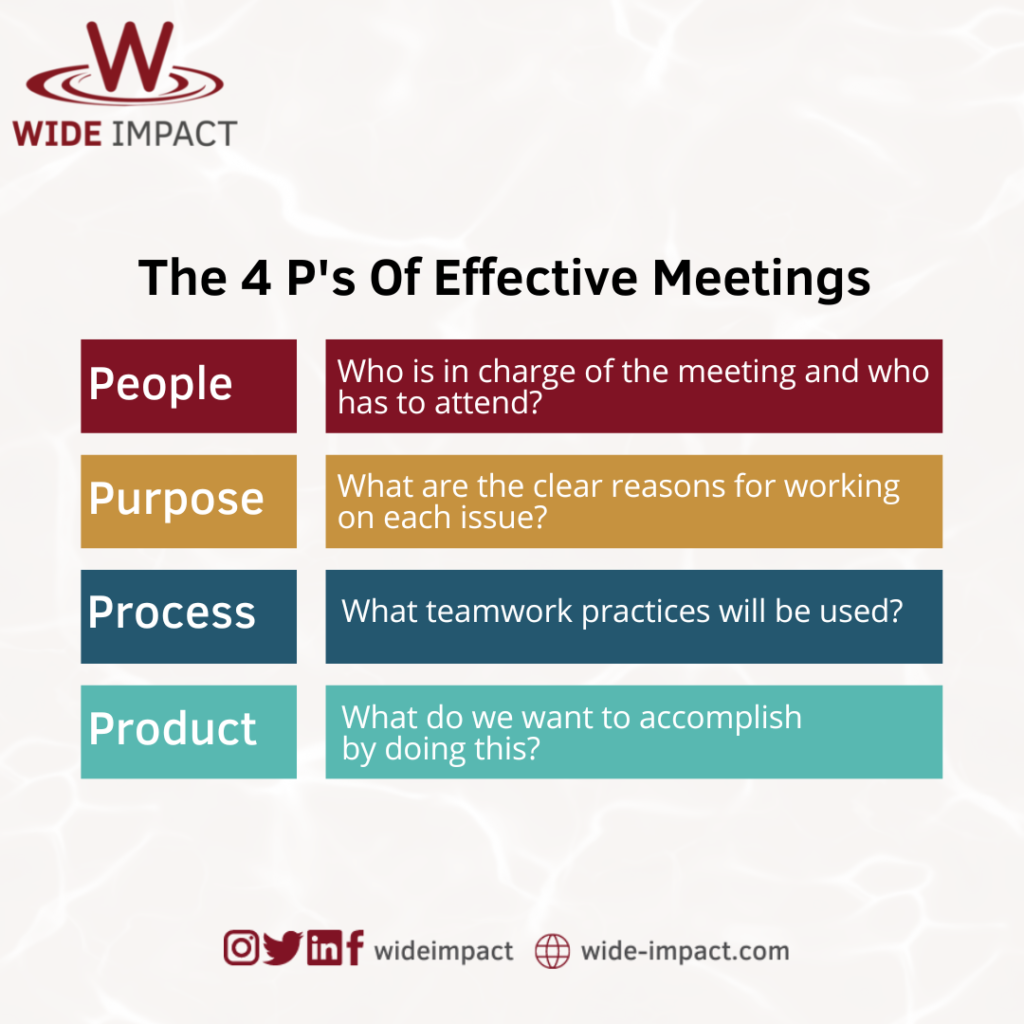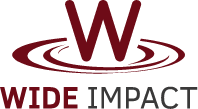
The 4 P’s of Effective Meetings is a one of Wide Impact’s corporate training module that is adapted from our training program “How to Have Effective Meetings”. The module explains what makes effective meetings as well as some tips on how to make them go better.
No one appreciates being bored. No one likes being talked at, and no one likes to spend hours in a room where others feel the need to constantly say words to each other. Yet, this is often the case in our daily business lives, whether it’s a team meeting or a conference call. So if you’re in an environment dealing with a lot of meetings and are looking for ways to improve what you’re doing, read on.
Meeting is a space to share knowledge, ideas, and perspectives. It allows for the expression of opinions, it gives people the opportunity to develop their skills through practice in front of others. It helps create a sense of connection between coworkers and can help them feel more like a team.
Nevertheless, Meetings can be boring, especially if there isn’t a clear agenda or purpose for the meeting. People might lose interest if they don’t feel like what they have to say is important enough. Meetings can be intimidating if you don’t know everyone in the room or if you are not confident speaking in public settings, which could make some people uncomfortable or afraid to speak up at meetings because they may feel like they don’t have anything valuable to offer at all.
What are the 4 P’s of Effective Meetings?
The key to any successful meeting is preparation and planning. By taking the time to properly prepare for your meeting, you can ensure that it will be fruitful, useful, and controlled.

Running a meeting is no easy feat. There are many things to keep in mind: the time, the agenda, the participants, and more, But there’s also one important factor that can simply help you run an efficient meeting, which is The 4 P’s of effective meetings.
Efficiency, productivity, and concentration may all be increased in any kind of group work or organizational meetings by using this framework. Let’s explore these four steps in detail and provide practical tools to help your team make the most of every meeting.
People: Who Is In Charge Of The Meeting And Who Has To Attend?
The most important part of any meeting is the people. Without the right people in attendance, a meeting is likely to be ineffective. The right people are those who have a stake in the outcome of the meeting, and who are able to contribute to the discussion.
Once you have confirmed that the right people will be in attendance, it is important to prepare for their arrival. Make sure that you have enough chairs and that everyone will be able to hear and see each other clearly. If possible, arrange for refreshments to be served prior to or during the meeting. This will help everyone to feel comfortable and relaxed, and it will create a more positive atmosphere for productive discussion.
Purpose: What Are The Clear Reasons For Working On Each Issue?
An effective meeting starts by having a clear and easy to read agenda that is sent out to everyone beforehand. This should include the topics to be discussed and what is expected from these discussions. It is advisable to know who will be leading each talk as well. Starting on time, with fresh members being introduced and an overview of the agenda helps keeps things focused on track. As the subjects are gone through, there should be brief confirmation of all parties being in agreement. After completing all points, there should be a summarizing of any agreements made or what happens next. To finish up, there must be a plan set into motion for further progress or action needed.
Process : What Teamwork Practices Will Be Used?
In order to have an effective meeting, there are a few key teamwork practices that should be used. The first is clear and concise communication. All members of the team should be on the same page in regards to the goals of the meeting, and everyone should be given a chance to voice their opinion.
Another important practice is active listening. This means really paying attention to what others are saying, and not just waiting for your turn to speak. This can help to prevent misunderstandings and miscommunication.
It’s also important to make sure that everyone feels like they are being heard and valued. Encourage team members to share their ideas, even if they may be different from your own. Be open to compromise, and remember that the goal is to work together towards a common goal.
By following these practices, you can ensure that your team is working effectively together and that your meetings are productive and successful.
Product: What Do We Want To Accomplish By Doing This?
The first step in planning an effective meeting is to decide what you want to accomplish. This may seem like a no-brainer, but it’s important to be clear about your goals before you start planning. Otherwise, you’ll likely end up with a meeting that doesn’t meet your needs or the needs of your attendees.
Some things to consider when setting goals for your meeting include:
– What problem are you trying to solve?
– What decision do you need to make?
– What information do you need to gather?
Who needs to be involved in this discussion?
once you’ve decided on the purpose of your meeting, you can start planning the rest of the details.
How to make sure your meetings are effective
To ensure your meetings are effective, there are a few extra key steps you can take:
- Define The Purpose Of The Meeting. What is the goal of the meeting? What do you hope to accomplish? Having a clear purpose for the meeting will help you determine who needs to be in attendance, what agenda items need to be covered, and how long the meeting should last.
- Choose An Appropriate Location. The location of the meeting can have a big impact on its success. Make sure to choose a place that is spacious enough to accommodate all attendees, has good lighting and acoustics, and is free from distractions.
- Create an agenda. An agenda helps to keep meetings on track and ensures that all important topics are covered. Be sure to send out the agenda in advance so that attendees can come prepared with questions or comments.
- Designate a facilitator or moderator. Someone needs to be in charge of keeping the meeting moving forward and keeping everyone on task. If possible, appoint someone who is neutral and objective to serve in this role.
- Establish ground rules. Ground rules help create a respectful and cooperative environment for discussion and debate. They also help prevent side conversations and other disruptions. Some common ground rules include maintaining confidentiality,
- Time management: All meetings should start and end on time. This will show respect for everyone’s time and helps to keep everyone focused and prevents unnecessary delays.
- Keep discussions focused on the topic at hand. If tangents arise, gently bring the conversation back to the main point.
- Encourage participation from all attendees. Ask everyone for their input and ideas – this will help build buy-in for any decisions made during the meeting.
- Summarize Key Points at the end of the meeting and assign action items to specific people if necessary. This will help ensure follow-through after the meeting is over.
- Follow-Up: After the meeting, there should be a follow-up plan in place to ensure that all action items are completed in a timely manner.
One of the simplest ways to test out the Four P’s of Effective Meeting Planning is to try them out on a meeting in which you participated recently. Can you articulate the purpose, People, Product, and Process made in that meeting? If so, great – you participated in an effective meeting! If not, what was missing? How would you change that meeting if you were to host it in the future?
Then, after applying the framework in retrospect, try applying to a meeting that you are planning. How does thinking about these four components change your approach to the meeting?
As always, if a second opinion could be helpful, don’t hesitate to reach out to Wide Impact; we’d love to help you info@wideimpact.com


